
After spending a night in Hanabanilla, we joined up with the formal photo tour led by Johnathan Esper, whom we met in Iceland in 2014, and Joel Hernández Marin, a professor of photography in Havana. We will be staying in Casas Particulares throughout our travels in Cuba, which are rooms in private homes. In Havana, we stayed in the Vedado neighborhood, which is in one of the wealthier neigborhoods. While the exteriors of the buildings appear shabby, the interiors have been remodeled and are immaculate for guests.
On the surface, Cuba has not changed much since 2005, when we first visited. There has been almost no new construction, and buildings that were rundown then still appeared in the same condition now. However, under the surface, there have been some major changes that are only apparent if you talk to the locals and ask. When we were last here, Fidel was still in power, though in failing health. Raul, his brother, was assumed to become president once Fidel stepped down. Since he had been in charge of the military for 46 years, it was feared he would be even stricter than Fidel on controlling the populace. Surprisingly though, he actually opened up parts of the economy and relaxed some of the harsher laws.
In 2013, Raul announced that two terms as president was enough and that he would not run for a third term. As such, Cuba will have a new president in 2018. When we were here last, cars and taxis were not allowed to travel between cities without a permit — they can now travel freely. In 2005, people legally owned their own homes, but were not allowed to sell them — Raul changed that in 2006 and people can now buy and sell their homes, which has led many to be converted into restaurants and short term rentals. When here last, gasoline was rationed, and we spent many hours traveling with a driver from gas station to station, trying to find someone willing to sell a ration coupon, so the driver could keep going — now gas is unlimited, though very expensive. In 2005, Cubans were not allowed to leave the island — they are now allowed to leave, though most countries are rather strict on who they allow to visit, for fear the Cuban visitor will overstay their tourist visa.
Two of the more visible changes are the diversity of restaurants and rooms for rent (Casas Particulares mentioned above). When here last, it was legal to rent out rooms to tourists, but not legal to advertise. As such, it was hard to find rooms. Each place we stayed had a “cousin” in the next city we were heading to, so our rooms were arranged the day of our travel through this informal network. Now, many of them are listed on AirBnb.
In 2005, it was hard to find a restaurant open at night, and we had one taxi driver knock on the door of a home, asking them to cook a meal for us. Now, there are a zillion restaurants in every town we visited, ranging from “basic fare” to extravagant feasts literally fit for a president. One of the restaurants (San Cristobal Paladar) where we ate at had been visited by President Obama, and the owner bragged that nine presidents had eaten at his restaurant. That meal was completed with a complementary (high quality) cigar — which we still have, but are determined to smoke at some point. ☺
Cubans earn between $20 to $40 per month. That includes doctors, since all health care is socialized in Cuba. Thus, a new “rich class” has evolved, which are those people who deal with foreign tourists, who will pay that much for a single meal, or double that for a room for one night.
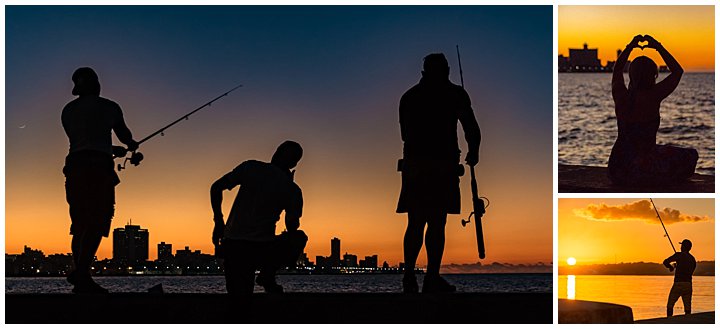
Our second evening in Havana was spent on the Malecón, watching the sunset with the skyline as a backdrop. Many men (almost no women) were fishing on the wall, making for dramatic foregrounds.
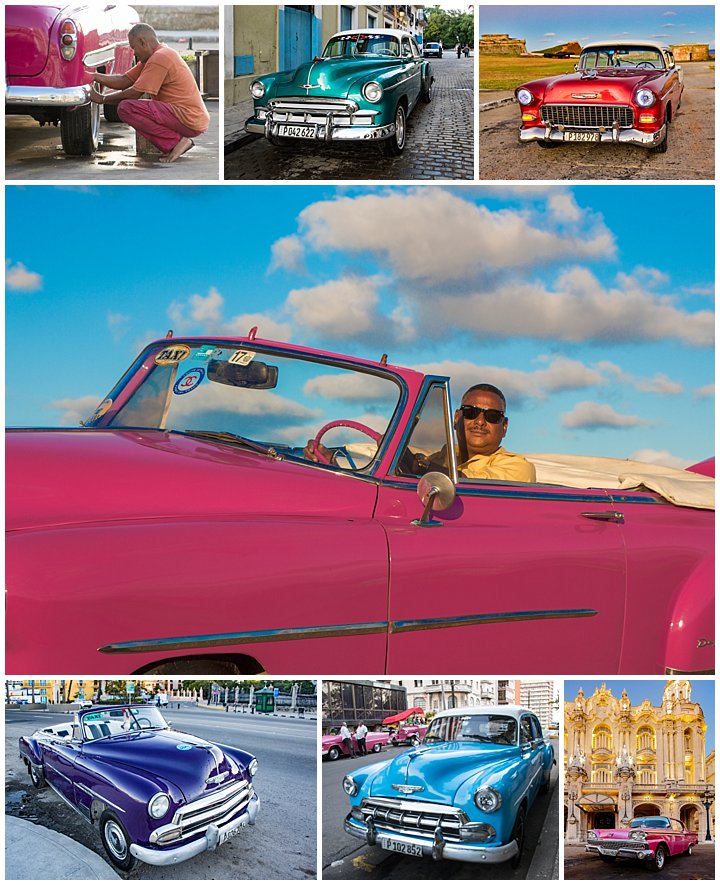
Most people think “American Classic Cars” when they think of Cuba. Yep, they are there, and we hired some to model for us on multiple occasions on this photo trip. The lower right image was from a sunrise shoot in front of the Gran Teatro de la Habana, home of the Cuban National Ballet.
However, these cars are not as universal as most Americans believe. There are plenty of modern cars in Cuba — just not modern American cars. Toyotas, Hyundais, Hondas, Chinese-made Geelys are all very common. The American vintage cars are mostly used for tourists as taxis, and rent out for up to $60 per hour (for a convertible), complete with driver, or $5 for a short taxi ride. I did a count several times, and found that the Classic American cars account for about 1 out of 8 cars on the road around Havana and Trinidad.
Many are held together by “glue and bailing wire.” Opening the hoods of almost any of these cars shows modern engines from the likes of Toyota or Honda, and in one case a Chinese tractor engine was installed. Likewise the suspensions and pretty much every part of the car has been replaced since new. Only the exterior body remains the 60-year old American classic.
Many Cubans cannot afford a car at all, so horses are a very common means of transportation in all the rural areas. With gasoline costing $6 per gallon, a typical government salary of $25 a month puts cars out of reach for most people.
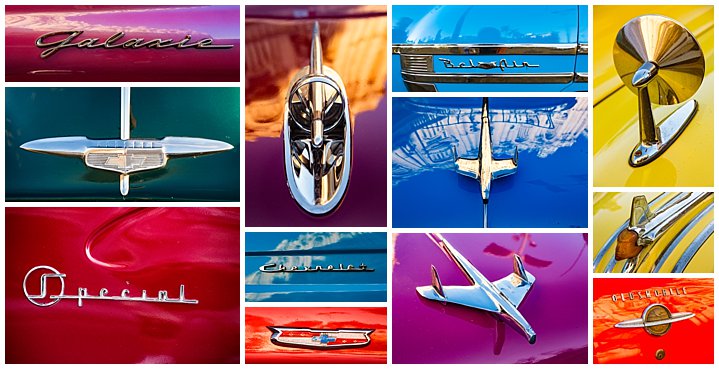
Each of the cars that were hired as models were well cared for with highly polished exteriors to be displayed for the tourists.
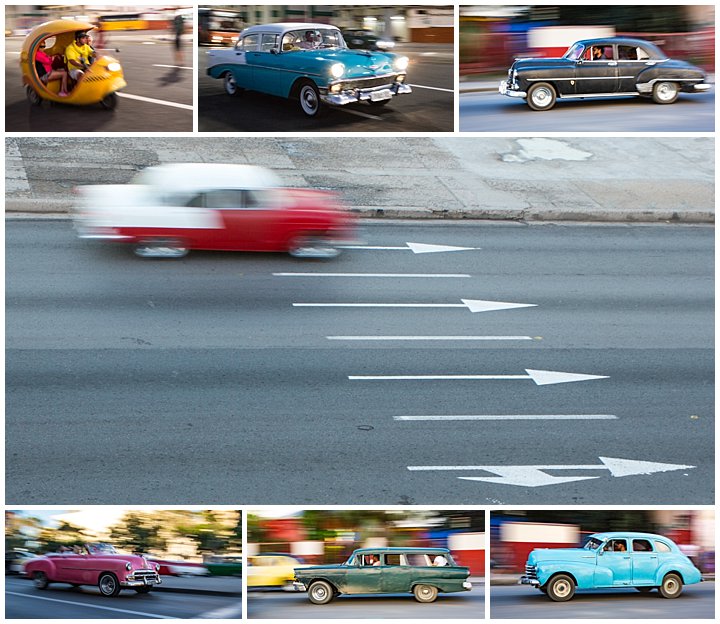
In addition to the cars we hired to model for us, we spent an hour or so photographing the Classic American cars that were driving past us near the National Hotel. There were also several 3-wheeled, auto rickshaw-type vehicles (Coco taxis — upper left) though we were warned they are actually the most expensive taxis in town.
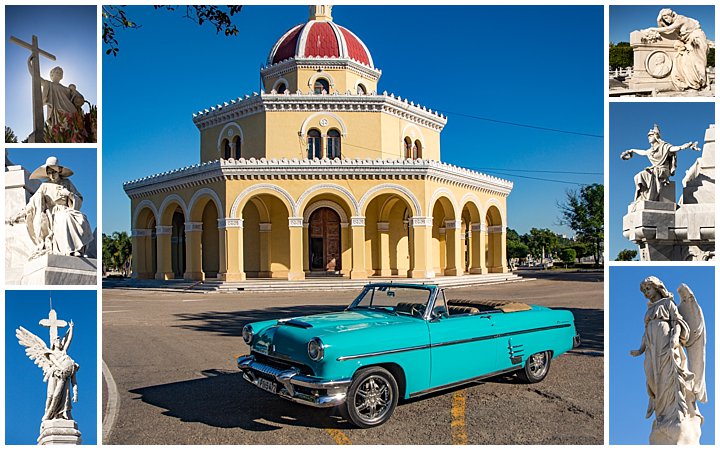
As part of the exploration of Old Havana, we visited various churches and squares, and had an opportunity to drive to the Colon Cemetery (above) in American vintage convertibles. For each place, we were shooting in good light, and took long siestas when the light was harsh. Such is the difference between taking a standard tour vs. going on a photo tour such as this.
Havana Cuba Restaurant Dance from Burt Johnson on Vimeo.
We were about to leave after dinner at one restaurant, when a band started up. We stayed to listen for a bit, and were about to leave again when this pair of dancers started strutting their stuff. They were the highlight of the evening.